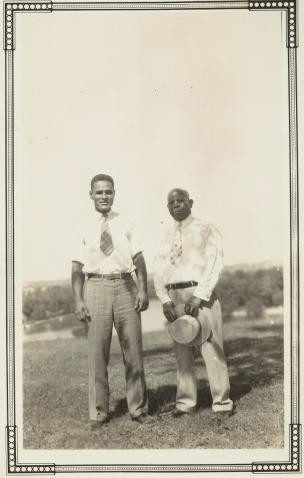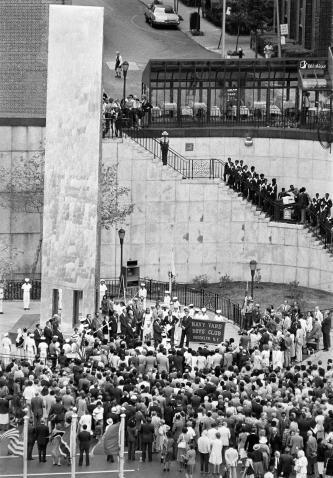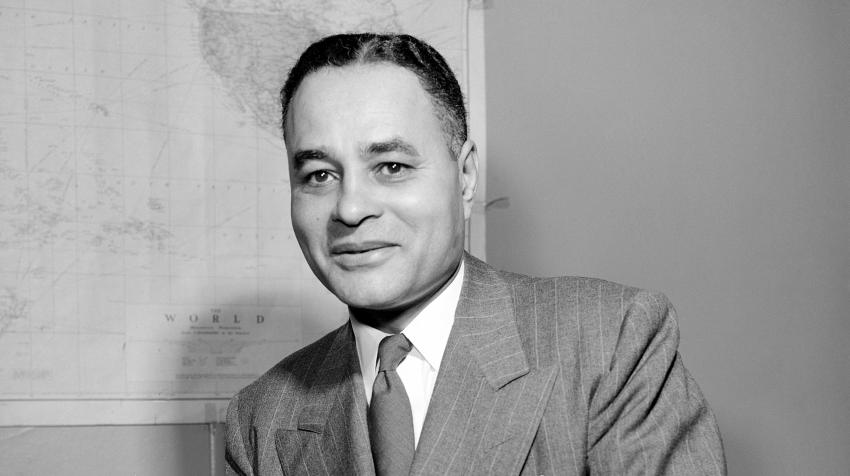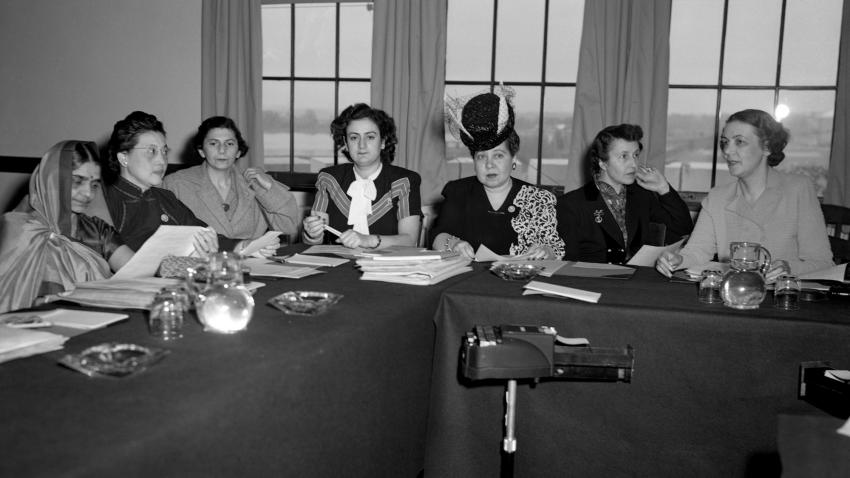“The shooting of Lloyd Hobbs, a boy having a good record both in school and in the community, and being a member of a family of good standing and character, has left the impression upon the community that the life of a Negro is of little value in the eyes of the police.”
from Mass Violence in America, The Complete Report of Mayor LaGuardia’s Commission on the Harlem Riot of March 19, 1935 (New York, Arno Press and the New York Times, 1969).
For weeks since the horrific killing of George Floyd at the hands of the Minneapolis police on 25 May 2020, which roused mass indignation worldwide, the district surrounding the Civic Center in Lower Manhattan, New York, has been seething with ever-evolving human emotions. It has become apparent that deep-rooted feelings of wrongs and denials can no longer be swept under the carpet, and that the persistent exertion of power fraught with prejudice and hatred will no longer be tolerated.
As I was frantically navigating the crowd control barriers mushrooming alongside boarded-up storefronts, determined not to violate curfews imposed upon a shuttered city, the tension I sensed was tangible and unsettling. Having previously acquired and shared knowledge about social injustice and racial discrimination exclusively in classroom settings or a library, I was not ready for these tumultuous street protests. Resorting to treatises that I used to scrutinize with my students, I found a number of them indispensable in coping with this bleak and troublesome urban chaos.
One of the volumes from an old syllabus that drew my attention in view of recent developments was An American Dilemma: The Negro Problem and Modern Democracy (1944), a monumental work that to this day remains the most exhaustive interdisciplinary examination of race relations in the United States. Published a year before the United Nations Charter was signed in San Francisco, it astoundingly resonates with the urgency of addressing the inequality that, in the words of United Nation Secretary-General António Guterres, "has reached crisis proportions around the world [...] and that poses a growing threat to our future."
While the study, sponsored by the Carnegie Corporation of New York, is deservedly attributed to Swedish Nobel laureate economist and sociologist Gunnar Myrdal, who led the research and was solely responsible for the final report, it was a true collaboration between established and fledgling scholars from a broad array of disciplines. One such contributor was Dr. Ralph Johnson Bunche, more prominently remembered as the first African American and person of color awarded the Nobel Peace Prize, a celebrated diplomat, illustrious international civil servant and fervent advocate for human rights. Yet much less is known outside academia about his scholarly legacy as a pioneering social and political scientist, who discerned the manipulative nature of the socially fabricated notion of race years before the Universal Declaration of Human Rights, which he helped to draft, was adopted. Ahead of his time, he warned against the dangers of fascism rising in Europe, unequivocally denouncing inequalities based upon racial differences on the cusp of the Second World War. Amidst the 75th anniversaries of the publication of An American Dilemma and subsequent founding of the United Nations, Bunche's early efforts to expand the discussion about race must be revisited to help dispel what Secretary-General Guterres calls "the delusion that we live in a post-racial world."
With the world economy currently plummeting into a deep recession, it may be prudent to revisit Bunche’s thoughts about these vested public works that can inform today’s efforts to ensure a sustainable and inclusive recovery and build back better.
I also take this opportunity to mark the 117th birthday anniversary of a visionary internationalist and humanitarian, whose memory lives on, above all, "in the long struggle for human dignity and against racial discrimination and bigotry."1
In 1934, at the age of thirty-one, Bunche completed a doctoral dissertation on French colonialism, having undertaken research in Paris and at the League of Nations archives, and having conducted field work in West Africa. Some of his conclusions would inform later contributions to the Carnegie-Myrdal project, define his approach to mediating peace and overseeing decolonization, and deepen his longstanding commitment to the civil rights movement. In 1936, Bunche published a booklet entitled A World View of Race, in which he rejected any scientific justification for the notion of race that was "sufficiently flexible" in its meanings to cultivate and rationalize group prejudices. He asserted that race was effectively used as a "stalking-horse" for inadequate policies and as "camouflage for brutal economic exploitation."2 Race relations, as Bunche observed, "were pregnant with danger for the future peace and development." Intended to subjugate, often at the point of the bayonet, the notion of race was used to bestow the “blessings of civilization” upon “backward” peoples, who “were put to work making their own resources available to the rest of the world” but “given little opportunity to share in the new wealth.”3 The ongoing oppression and responses to it, according to Bunche, inevitably create racial stereotypes that victimize all sides involved.4 Regardless of how deplorable their own plight might be, dominant groups are “placated” by illusions of their “social superiority”, assuming for themselves political and economic privileges.5
This was Bunche’s understanding and vision of race and race relations before he joined Gunnar Myrdal's research team. Having grown up in a legally segregated country where he inevitably encountered prejudice, Bunche wielded an “intuitive grasp of racial complexities in America”,6 thus becoming an indispensable contributor to the project.
By the spring of 1939, when Myrdal began recruitment, Ralph Bunche had just completed his postdoctoral studies in anthropology at the London School of Economics and the University of Cape Town in South Africa. Upon his return to the United States, he was appointed full professor at Howard University, teaching classes in American Government and Constitutional Law. Bunche enthusiastically joined the project, being excited by its possibilities.7 He authored four researched monographs that were to serve as informational references to draw upon for the final edition of the study. The most substantial of them was “The Political Status of the Negro”, which was strongly influenced by his own experience as an African American and scholarly interests in organizations working towards the advancement of people of color, as well as in voting and political practices in southern United States. One of the most cited pieces of research, however, is “Conceptions and Ideologies of the Negro Problem”, dated 5 March 1940. Myrdal had studied and admired the latter, which arguably may have provided the title and theme for the volume.8 Adhering to previously pronounced convictions regarding the danger of race as a socially constructed device employed to rouse and rationalize emotions, Bunche approached the problem within the broad boundaries of time and space, tracing an evolving mythology that would gradually obscure intellectual processes, carefully guarded from becoming the “subject of doubt or test.” “Very few problems,” Bunche wrote, “have been so fraught with dilemma, so charged with emotional content, so persistent, and so little thought out.”9

Unlike Myrdal, who believed that the “American Creed,” an array of beliefs supposedly internalized by all Americans, would prevail over “group prejudice against particular persons or types of people”,10 Bunche spared such gratification, stating that the contradiction between American ideals and anti-Black racism had been conventionally rationalized since slavery had developed into a fundamental institution, and it became necessary to reconcile human bondage with “the ideological scaffolding of democracy.”11 Rather than suggesting, as Myrdal did, that reliance upon moral appeals to the guilt-ridden conscience of generally well-meaning Americans would allow reforms within the existing social organization, Bunche called for structural change, urging the need for a "crusade,” and “unrelenting struggle” that would “erect a true democracy upon [...] constitutional foundations". The dilemma of the blacks could thus be “solved only in terms of full opportunity for development and complete assimilation into the political and economic life of the nation.”12
Bunche's submission to Myrdal's book provides a detailed analysis of the historic role of the New Deal, a series of government relief programmes and reforms introduced by American President Franklin D. Roosevelt to aid in the nation's recovery from the Great Depression. Initially Bunche did not trust that “a more enlightened planning” would significantly “shift ideas, traditions, or loyalties",13 challenging racial stereotypes. But the research for Myrdal’s volume persuaded him that certain features of the United States Government’s economic and social undertaking could in fact be considered beneficial from the perspective of African Americans. Among other hopeful signs, Bunche recognized that low-income housing, social security, minimum wage and hour legislation, along with the Labor Relations Act, all contributed to the betterment of African Americans more “than the broadest conceivable decision of [their] equal rights.”14 He emphasized the importance of the inclusion of African American New Deal advisers, who could attempt to assure that millions in government assistance and services would be made available to meet the needs of the African American population. Although Bunche realized that those policies did not go far enough to alleviate the plight of the countless unemployed, the measures helped to pave the way for minorities “to begin the process of achieving economic and political freedom.”15 With the world economy currently plummeting into a deep recession, it may be prudent to revisit Bunche’s thoughts about these vested public works that can inform today’s efforts to ensure a sustainable and inclusive recovery and build back better. The economic security of hundreds of millions the world over is still inhibited by such “evils,” as “the political and educational disabilities,” “the slum areas,” and “inadequate protection of […] health.”16 These recommendations, advanced by Ralph Bunche nearly a century ago, make the study once again timely and relevant.
The magnitude, scope and structure of An American Dilemma, which consists of forty-five thoroughly researched chapters, ten appendixes and many tables, reveal how racial strife permeated every aspect of American life. It would have been impossible then, as now, to either understand or adequately deal with race-related injustice, in whatever form, without conscientious and sincere willingness to acknowledge its controversial history and analyse the political, economic and social forces at work. Unlike its predecessors that avoided making recommendations for public policy, Myrdal's book has served as a comprehensive source of information, as well as "a guide to policymakers."17 Most notably, the publication helped put an end to the practice of segregation as unconstitutional, when it was referenced in Brown v. Board of Education (1954), a landmark United States Supreme Court ruling. Findings from the book were used as evidence against the "separate but equal" principle, proving that separation implied and enforced inferiority.
Whatever form they may take, discriminatory policies and practices have remained prevalent, and the ongoing crisis disproportionally impacts women, communities of color, minority groups and the most vulnerable.
Seventy-five years after Bunche denounced the use of racial doctrines as a device for imperialist arrogance, the unjust exploitation of natural resources, whether high-value materials such as timber, diamonds, gold, minerals and oil, or scare commodities, including fertile land and water, continues to fuel violent conflicts.18
It took the decades-long journey of the United Nations system and any number of sociologists, economists, lawyers, social psychologists, ethnographers, historians, geneticists and other experts, including major researchers contributing to An American Dilemma, wrestling with statements on the race question, before the General Conference of UNESCO adopted a "Declaration on Race and Racial Prejudice" in 1978, affirming that there was no scientific foundation for theories of racial or ethnic superiority. As defined in the fourth UNESCO statement on race and racial prejudice of 1967, however, and as the COVID-19 pandemic has revealed with even more poignancy this year, racial discrimination "continues to haunt the world, stultifies the development of those who suffer from it, perverts those who apply it, divides nations within themselves, aggravates international conflict and threatens world peace."19
United Nations anti-discrimination treaty efforts have continued, most notably resulting in the International Convention on the Elimination of All Forms of Racial Discrimination, which entered into force in 1969. Heralding a human rights approach in challenging the essentialist understanding of race, the Organization undertook a campaign against the apartheid regime, resulting in a temporary suspension of a Member State from participating in the work of the General Assembly. Less than a decade after South Africa was readmitted to the United Nations, following its transition to democracy in 1994, it hosted the World Conference against Racism, Racial Discrimination, Xenophobia and Related Intolerance, in 2001.
Yet racism persists. Revealing growing skepticism regarding race relations, in his 1967 essay "Upheavals in the Ghettos", Bunche dubs racism "a dangerous virus",20 which may be spread from either side of the color and ethnicity divide. Its heavy toll cannot be underestimated, as racism is as pervasive and destructive as today's novel coronavirus that traumatizes despondent individuals and communities, leaving them permanently wounded. As with the pandemic, it is imperative to continue looking for remedies while applying preventive measures. In order to eliminate "the breeding grounds" of grievances, it is necessary to identify and address them. Undertaken seventy-five years ago, the Carnegie-Myrdal project was an early attempt to do so, an effort that remains unsurpassed to this day. In addition to the longstanding underlying causes researched in An American Dilemma, the fallout over the pandemic has delineated new or previously less conspicuous forms of racism, such as ever-increasing environmental discrimination. Decades of neglect and underinvestment in housing, infrastructure and environmental safety resulted in a merging of the struggle for social justice with the urgent need for the green deal. Whatever form they may take, discriminatory policies and practices have remained prevalent, and the ongoing crisis disproportionally impacts women, communities of color, minority groups and the most vulnerable.

Reforms mandated by legislative and judicial actions are important and have often been effective in combatting prejudices, as Brown v. Board of Education suggests. But, as a writer Caryll Phillips notes, "we can't legislate what is in people's hearts,"21 which, he admits, places additional responsibility upon all of us, including teachers, parents, community organizers, public figures and, of course, international civil servants. In the same vein, widespread urban unrest may not be smothered even by the intervention of federal security forces. Instead, these measures, as it has become obvious in recent days in a number of American cities, caused protests to swell, embracing other groups such as mothers and veterans. Demonstrators return to the streets, driven by the same "sense of justice and deep concern for all people and problems"22 that drove Ralph Bunche to address an enormous crowd at the legendary 1963 March on Washington, just before Martin Luther King delivered his memorable speech, and later to join the Reverend Dr. King in Alabama in the front line of the March on Montgomery from Selma.
Sixty-five years later, and two thousand miles from Selma, a new generation of activists are drawing inspiration from a civil rights history that "exposed segregation's endemic violence" and resulted in the Voting Rights Act of 1965. Led by Ms. Patrisse Cullors, an African American artist, activist, public speaker and co-founder of the Black Lives Matter movement, a coalition of reformers in Los Angeles is harnessing the power of the vote through a ballot measure designed to "stop Sheriff violence and abuse in jails".23 As is often the case, dedicated humanitarians, their legacies, intentions and influences are destined to converge at some point. Had the world not shuddered with horror in the wake of the senseless killing of a Black man in Minneapolis last spring, it may have remained widely unnoticed that Ms. Cullors received the Ralph Bunche Humanitarian of the Year Award. A Los Angeles native on the frontlines of criminal justice reform for more than twenty years, she was recognized for her service to the African American community. Weeks later, the movement that she helped found gained a new level of prominence. It urged the world to accelerate common efforts in search of a cure for "the dangerous virus of racism", which continues to strip human beings of their inherent empathy and compassion, and intoxicate the afflicted with the savage pleasure of brutal aggression.
Notes
1 Brian Urquhart, Ralph Bunche: An American Life (New York, London, W.W. Norton and Company, 1993), p. 458.
2 Ralph J. Bunche, A World View of Race (Washington, D.C., The Associates in Negro Folk Education, 1936), p. 25.
3 Ibid., p. p. 38-40.
4 John B. Kirby, "Ralph J. Bunche and black radical thought in the1930s", Phylon, vol. 35, No. 2 (2nd Qt., 1974), p. 131.
5 Bunche, A World View of Race, p. 26.
6 Dewey W.Grantham, "Editor's introduction", in The Political Status of the Negro in the Age of FDR, Ralph J. Bunche (Chicago, London, The University of Chicago Press, 1973) p. xii.
7 Ibid.
8 Clare L. Spark, "Race, caste, or class? The Bunche-Myrdal dispute over An American Dilemma", International Journal of Politics, Culture, and Society, vol. 14, No. 3 (March 2001), p. 473.
9 Ralph J. Bunche, "Conceptions and Ideologies of the Negro Problem". A Research memorandum. Carnegie-Myrdal Study. The Negro in America (New York,1940), p.p. 5, 3. The Social Science Research Council. Available at https://anamericandilemma21c.org/article/conceptionsandideologiesofthenegroproblem_5da5db40d5335b3bbaad9abc.
10 Gunnar Myrdal with the assistance of Richard Sterner and Arnold Rose, An American Dilemma: The Negro Problem and Modern Democracy (New York, London, Harper and Brothers Publishers, 1944), p. xlvii.
11 Bunche, "Conceptions and Ideologies of the Negro Problem", p. 9.
12 Ralph J. Bunche, "The Negro in the political life of the United States", Journal of Negro Education, vol. X (July 1941), p. 583, 581. Cited in Kirby, "Ralph J. Bunche and black radical thought in the 1930s", p. p. 135, 137.
13 Kirby, "Ralph J. Bunche and black radical thought in the 1930s", p. 134 and Ralph J. Bunche, “A critique of New Deal social planning as it affects negroes", Journal of Negro Education, Vol. V (January 1936), p. 60. Cited in Kirby, "Ralph J. Bunche and black radical thought in the 1930s", p. 133.
14 Ralph J. Bunche, "The Political Status of the Negro with Emphasis on the South and Comparative Treatment of the 'Poor White'". A Research memorandum. Carnegie-Myrdal Study. The Negro in America, Book VI (New York,1940), p.p. 1530-1531. The Social Science Research Council. Available at https://ssrc-myrdal.s3.amazonaws.com/4e401ee5208548418258b15e68a9c916.pdf .
15 Kirby, "Ralph J. Bunche and black radical thought in the 1930s", p. 134.
16 Ralph J. Bunche, "The Negro in the political life of the United States", 538. Cited in Kirby, "Ralph J. Bunche and black radical thought in the 1930s", p. 135.
17 Urquhart, Ralph Bunche: An American Life, p. 83.
18 For more information on conflict and natural resources, see United Nations Peacekeeping, "Conflict and natural resources". Available at http://peacekeeping.un.org/en/conflict-and-natural-resources.
19 UNESCO, "Statement on race and racial prejudice, Paris, September 1967", in Four Statements on the Race Question (Paris, 1969), p. 50.
20 Ralph J. Bunche, "Upheavals in the Ghettos," in Ralph J. Bunche, Selected Speeches and Writings, Charles P. Henry, ed. and "Introduction (Ann Arbor, The University of Michigan Press, 1998), p. 290.
21 Caryl Phillips, "American tribalism", in The American Effect: Global Perspectives on the United States, 1990-2003 (New York, Whitney Museum of American Art, 2003), p. 91.
22 Ralph Bunche, "March on Montgomery Speech, 1965", in Bunche, Selected Speeches and Writings, p. 259.
23 Patrisse Cullors, ""Selma to LA: How civil rights history inspired modern criminal justice reform and Measure R", Daily KOS, 25 February 2020. Available at https://www.dailykos.com/stories/2020/2/25/1921770/-Selma-to-LA-How-civil-rights-history-inspired-a-modern-campaign-for-criminal-justice-reform.
The UN Chronicle is not an official record. It is privileged to host senior United Nations officials as well as distinguished contributors from outside the United Nations system whose views are not necessarily those of the United Nations. Similarly, the boundaries and names shown, and the designations used, in maps or articles do not necessarily imply endorsement or acceptance by the United Nations.




